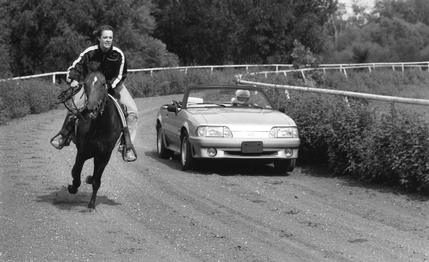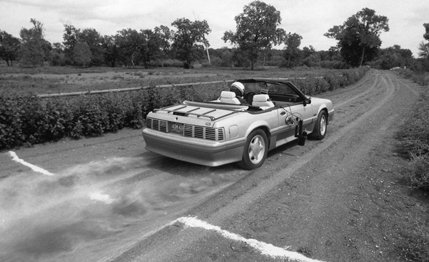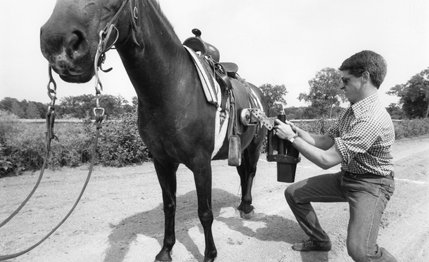 Archived Comparison
Archived Comparison
Regular readers will recall our "Beretta versus Beretta" comparison test (C/D, February 1989), wherein we compared a Beretta 92F handgun and a Chevrolet Beretta GTU. In that same spirit of enlightenment, we now pit a Ford Mustang GT against a representative of its namesake, the spunky sure-footed Equus caballus, known variously as the cayuse, the bronco, or the mustang. Mustangs are descended from escaped Native American horses, which in their turn were descended from horses brought to America by the Spanish in about the year 1500, give or take a century. Anyway, long before there were Taco Bells.
We realized at the outset that the Mustang would have something of a horsepower advantage—225 to 1, to be precise—but we thought we could even the odds by bringing our vast store of scientific knowledge and true facts into the equation. Our test is real scientific and uses sophisticated equipment to generate lots of data. Data from which we can draw conclusions and stuff. A gallop poll, if you will.

We chose the Dallas area to conduct our comparison largely because that city, known far and wide as the Athens of East Texas, is home to many knowledge-intensive colleges and universities and is the future site of the plenty sophisticated and gosh-darn scientific multibillion-dollar Superconducting Supercollider. Dallas was also the only city where we were able to locate a car, a horse, and a horse track owned by a guy who didn't mind us doing dusty Goodyear burnouts where his racehorses usually run.
The car was a 1991 5.0-liter Ford Mustang GT convertible, a leather-lined top-of-the-liner saddled with a list price of more than $22,000. To drive it, we enlisted ex-drag-racing star Billy Meyer, who at sixteen possessed an NHRA Funny Car license—the youngest driver ever to turn that chronological trick. In the ensuing 21 years, Meyer won dozens of races, many of them in Mustang-bodied cars. He is currently contemplating a return to competition—this time in a Top Fuel dragster. Meanwhile, Meyer keeps busy operating the deluxe Texas Motorplex, the drag strip in Ennis he built in 1986.
Moving into the starting gate alongside the car is Tang, a fourteen-year-old mustang mare owned and ridden by Ellen Nelson, founder of the North American Mustang Association and Registry (NAMAR). Tang was a wild, eight-month-old filly from New Mexico when Nelson adopted her at one of the government-operated centers that seek homes for some of the 40,000-plus wild mustangs that still roam the plains.

Our track is a half-mile dirt oval in Mesquite—the suburb of Dallas, not the charcoal. It's part of Ash Grove Farms, where owner Bobby Fisher raises Some of the Finest Thoroughbreds in These Parts. Fisher asked us to mention that, in lieu of charging us to use his track. If the track looks a little weedy in the pictures, it's because Fisher's tractor burned up shortly before our tests were conducted.
To bring technical expertise aplenty to the test, Car and Driver dispatched technical editor Frank Markus, a college graduate, to Texas. Markus brought along many tens of thousands of dollars' worth of test equipment, including an optical-eye fifth wheel, which doesn't use a fifth wheel at all, and a radar gun attached to a printer.
Was the equipment array an impressive array? Yes, but troublesome. The data-gathering fifth-wheel unit, which secures itself to its subject with a couple of big suction cups, worked well enough on the Ford but proved unaccountably difficult to attach to Tang's sweating horsehide and saddle-soaped leather.